
Walking Waterways; Wherries and Weavers
Norfolk is not normally considered the first choice when considering industrial archaeology, but you would be wrong. This walk takes you to some stunning natural wetland landscapes, but there is also wealth of Industrial archaeology hidden in plain sight. To the north of Wayford Bridge the old course of the River Ant has been straightened and canalised in part, forming a section of the North Walsham and Dilham Canal, Norfolk’s only true canal. The canal which opened in 1826, was nearly 9 miles long, and extended as far as Antingham Bone Mills. The Norfolk wherries used to ply their trade along the canal, sadly no longer, but these historic boats with sails hoisted can still be seen elsewhere in the broads if you are lucky.
The canal had six locks with Lock No 1 at Honing, now the furthest extent of water access for canoes and small craft. The main function of the canal was to improve the navigation for the wherry trade which served the farms and a series of watermills connected to the River Ant from Dilham northwards.
As well as Honing lock, walkers can also cross this southern section of the canal at historic Tonnage Bridge. The bridge partly collapsed in 1980 but has been rebuilt.
The canal suffered commercially following the building of the Great Yarmouth to North Walsham railway. Early schemes to encourage leisure use were unsuccessful. By 1923 traffic had reduced to six wherries and by the early 1930s there was only one, the ELLA, which last used the canal in 1934. The disused route of the railway crosses this area and now forms part of the long-distance Weavers’ Way footpath. The line of the route has now naturalised to the extent that it is hard to imagine it as a railway line, however a crossing keeper’s cottage and other traces of railway archaeology offer clues to its former use.
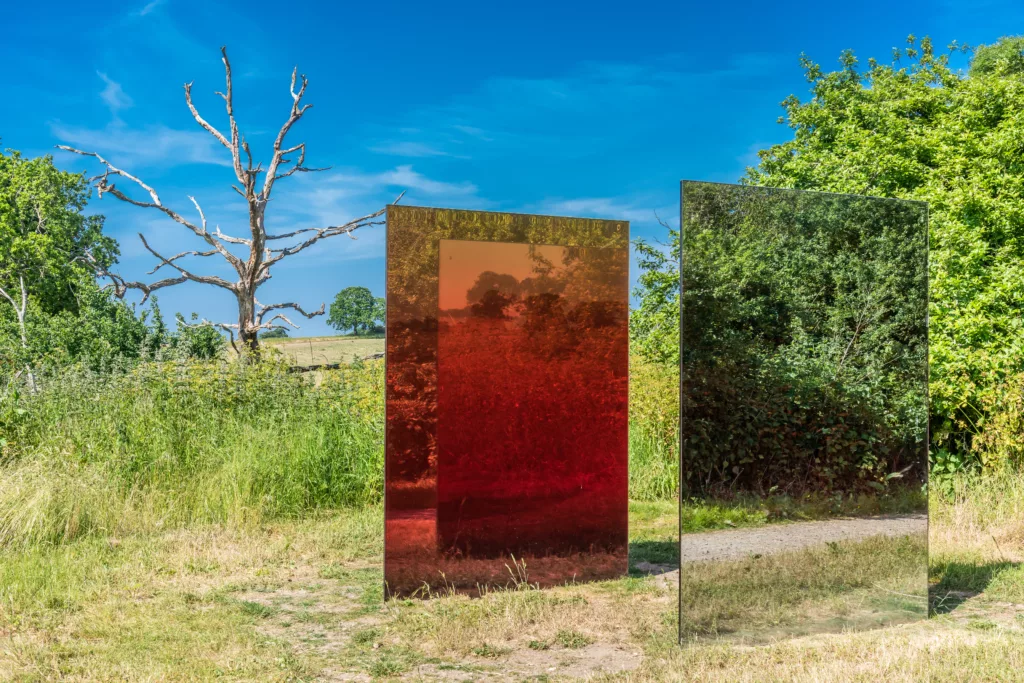
Honing Passage by Studio Sabine at Honing Station
Part of the Norfolk Way Art Trail, Honing Passage by Studio Sabine, is created from two offset glass surfaces that reference the history of the area and the movement of railway carriages that used to travel on nearby tracks. Forming a void, the space between the panels, or ‘passage’, is designed to encourage interaction from visitors, as they are invited to fully immerse themselves in colour and reflection. A unique place for the community to interact, reflect and enjoy nature, the passage embraces the beauty of the local landscape, framing the surroundings through a unique lens.
Community photography workshops were held around the Honing Station area by the Norfolk-based photographer, Debby Besford. Participants were invited to take photos of the beautiful natural bright colours that they encountered along the tracks of the old railway line. A photograph from the workshops, selected by the artists, has been used to inform the colour palette of the final design of Honing Passage.
Outside of the passage, the mirrored surfaces reflect their environment without alteration, seamlessly blending the piece into nature. Inside, the walls act as lenses, filtering all it reflects through layers of colour.
The artwork is activated by the seasons, offering a new way to look at the natural site and its ever-changing state. Its vibrant colours are taken from photographs of the area by members of the community and offer a great contrast with the site, especially during the winter season.
The other artworks which form the Norfolk Way Art Trail are Iron Reef at Reedham Ferry Inn, Flock at Diss Mere, Interval at Eastbourne Place in Norwich and Flint at Norwich Arts Centre
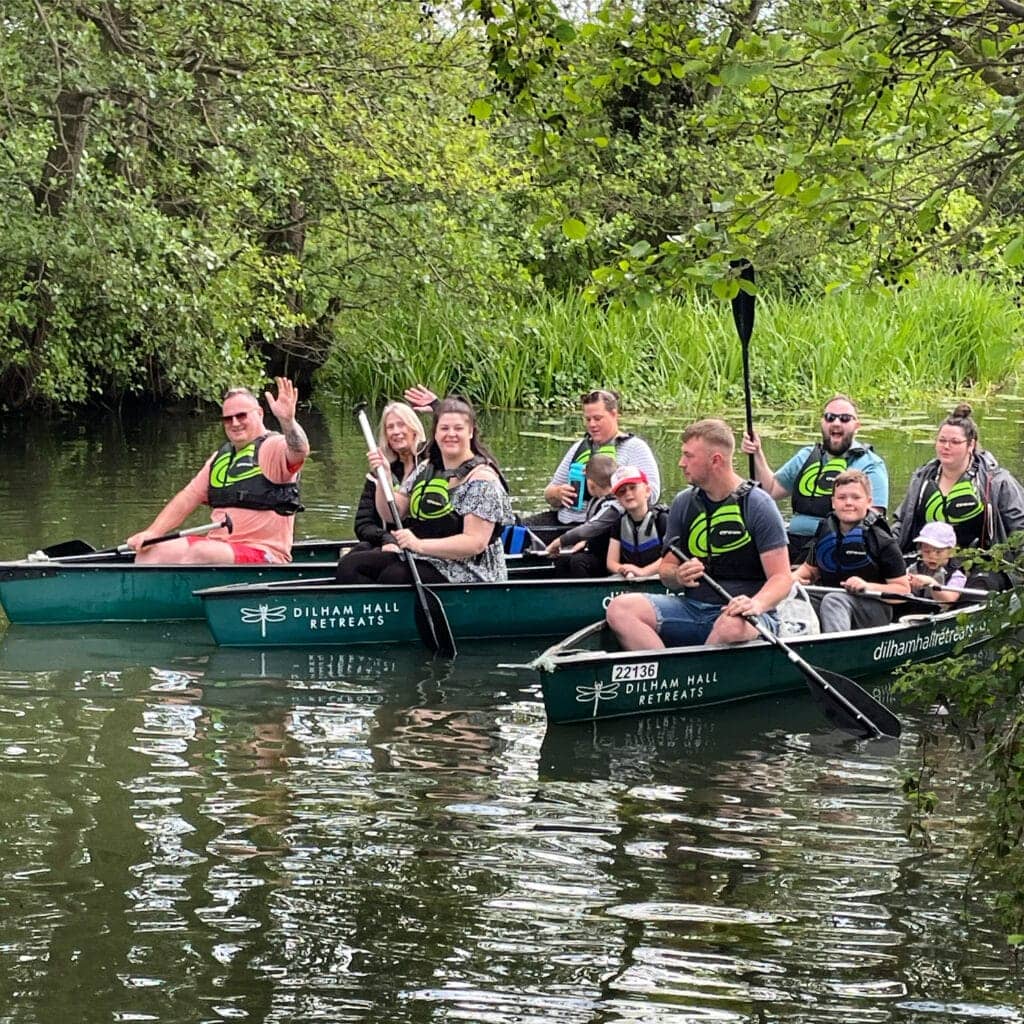
Dilham Hall Retreats: Canoe/Kayak & SUP Hire
Explore a little known area of natural beauty perfect for weekend adventurers, waterside picnics, birdwatching, photography and spotting autumn wildlife.
Explore Norfolk’s only Wherry canal on the water, paddling Canadian style canoes, on solid stand-up paddle boards (SUPs), in double kayaks or solo in a single kayak from Dilham Hall Canoe Hire (life jackets included). This lovely canal is only nine miles long, so no need to rush, just go with the very slow flow. The old waterway may be short, but it’s rich in wildlife which comes out to play more boldly as summer fades. You may even see otters or the cobalt blue flash of a kingfisher.
100 Bedford navvies started digging the canal in 1825 and it was opened in1826, running from Antingham, north west of North Walsham, to Wayford Bridge, west of Stalham. The main traffic was the handsome Norfolk Wherry Boats, taking cargo to and from the mills and communities along its length. The arrival of the railways marked the end of this slow, low impact way of transporting goods and the last Wherry, ‘Ella’, sailed in 1934. The canal fell into decay, choked and crumbling until being restored by volunteers from the East Anglian Waterways Association. Those magnificent old vessels have gone, yet this is a beautifully peaceful spot to canoe or paddle board, following the historical ripples of the old Norfolk Wherries. If you grow to love it, how about joining a working party to help the ongoing restoration?
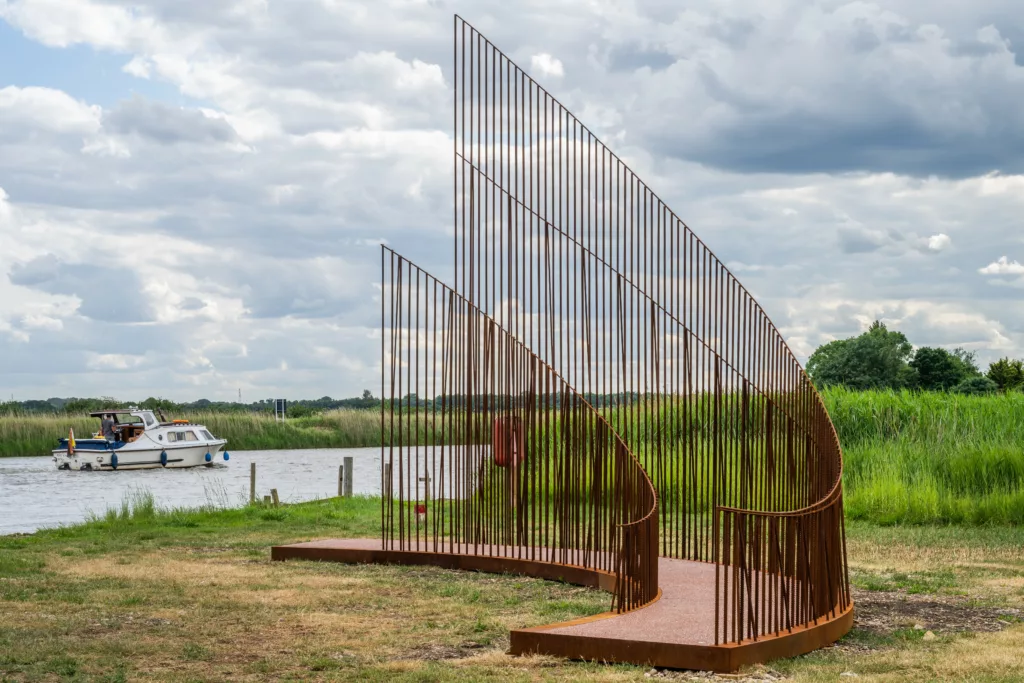
Iron Reef by Studio Maetherea, at Reedham Ferry Inn
Part of the Norfolk Way Art Trail, Iron Reef by Studio Maetherea at Reedham Ferry Inn is inspired by the nautical heritage of Reedham Ferry and is designed to interact with the surrounding landscape. The tides and the river currents change the artwork’s material over time, creating different colours and textures with the passing seasons.
The curved light metallic structure climbs to the sky and interacts with the wind. The vertical elements gently undulate, echoing the reeds on the horizon and inviting visitors to contemplate the changes in season on the River Yare. Winter tides mirror the artwork, blurring the line between the land and the water.
Iron Reef is deeply rooted in the community. Residents took part in a series of creative workshops, exploring the artwork and inviting them to reflect on their experiences. Participants created diary entries filled with interesting stories, poetry, and drawings as well as their experiences of the landscape, alongside sensory walks, which influenced the artwork’s design and composition.
Iron Reef will change through time, shaped by water, plants, animals and people. It’s raised platform, formed of a timber walkway and finished in a bioluminescent material, invites visitors to view the River Yare through vertical steel struts which reach heights of up to 12 metres.
The other artworks which form the Norfolk Way Art Trail are Flock at Diss Mere, Honing Passage at Honing Station, Interval at Eastbourne Place in Norwich and Flint at Norwich Arts Centre
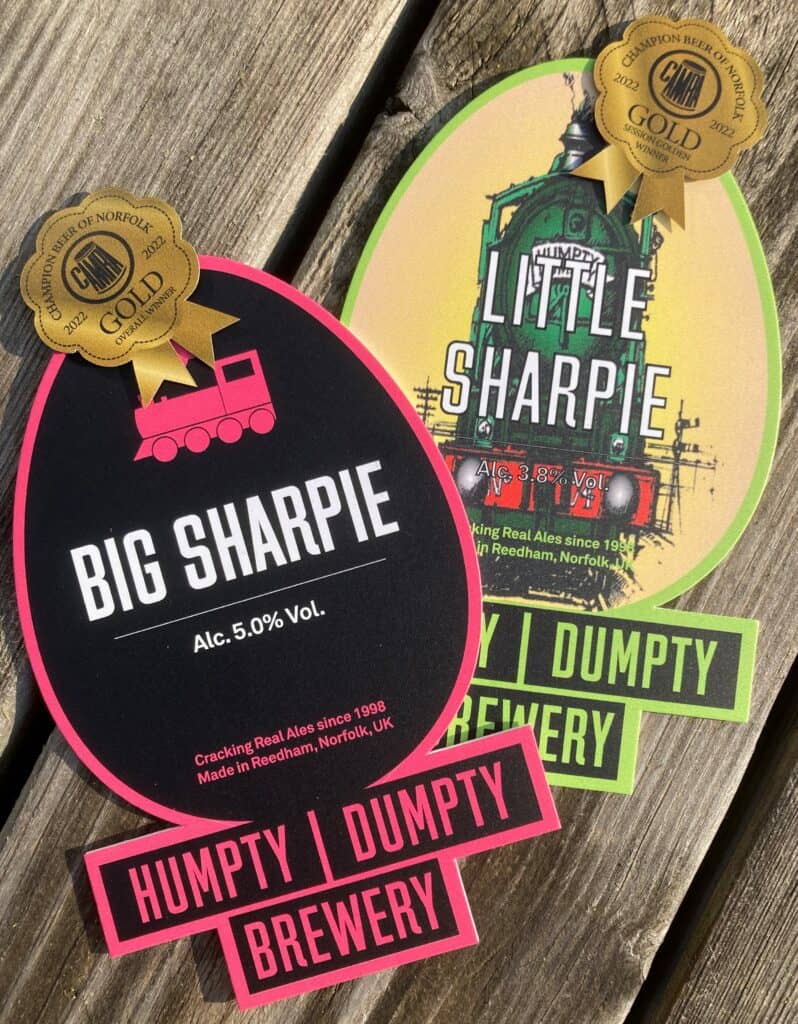
Brewery Visit & Shopping Experience
This Humpty Dumpty never sat on a wall and the name is nothing to do with the nursery rhyme! It’s a friendly multi-award winning microbrewery at pretty Reedham in the heart of the Norfolk Broads National Park, delivering cask and bottled real ales to pubs and venues across East Anglia. The 11 barrel brewplant, produces a wide range of award-wining real ales and very fine locally brewed Broadland beers. This is a chance to visit the brewery, try a few beers & source delicious local produce. Learn how the champion beers are made & how the different Humpty Dumpty brands are developed, many created in collaboration. And find out how a heritage train gave the brewery it’s name!
If you’re looking for foodie presents or gifts for beer lovers, browse the brewery shop, stocked with lots of East Anglian produce from brilliant local independents. It’s great way to support several local businesses at once, as Humpty Dumpty sources materials locally as possible, employs local people and sends their spent grain to local farms as feed for cattle. You’ll find their Humpty Dumpty’s range of bottled beers and tasty ciders, gins, wines, cookies, honeys, preserves, hot chilli sauces and lovely fresh local eggs. You can grab a pint or takeout jug too. Look out for guest ales from other East Anglian breweries and delectable seasonal specials. Humpty Dumpty loves autumn, as September is hop harvesting time. And ends with UK-toberfest, Oktoberfest with a British twist!
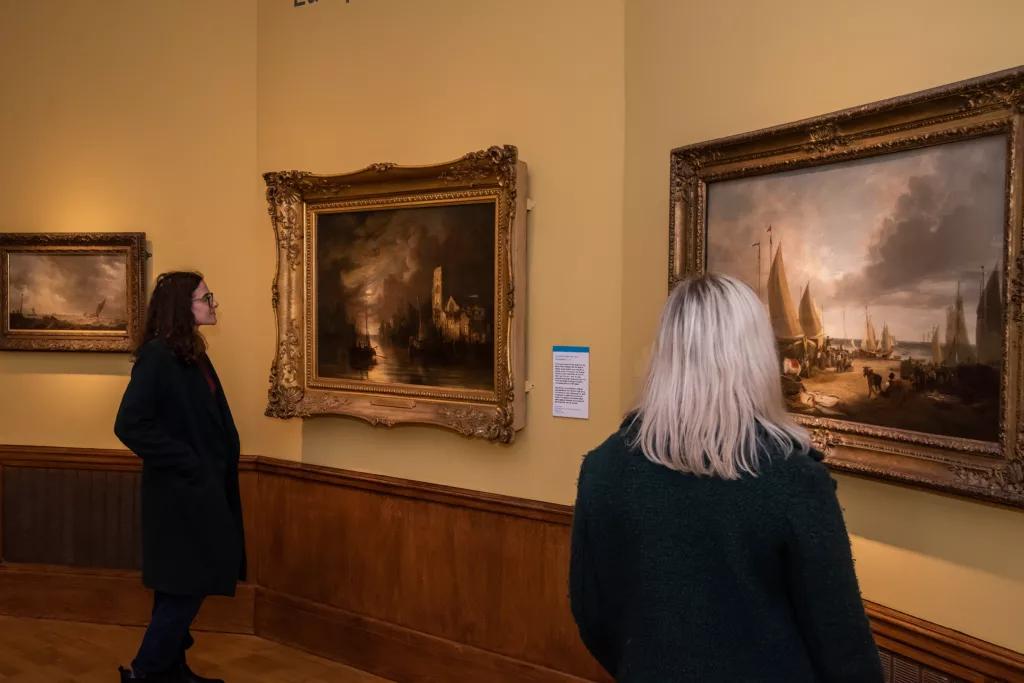
Norwich School of Artists
Norwich Castle may well have the grandeur and imposing architecture of a medieval fortress, but inside these robust walls is a gentler artistic side. Walk into the interior and you will find much more than display cases full of Norfolk history. Wander to one of the five art galleries and you can immerse yourself in visual vista by some of the world’s great artists. Although, perhaps ‘while in Rome’ opt for the Colman or East Anglian Painters Galleries. Here you find, like the names suggest, local artists who painted the Norfolk landscape generations ago. The Colman Gallery has a selection of the Norwich School of Artists, in fact it’s home to the world’s largest collection of works by artists of the Norwich School, a collective of three generations. This includes John Crome, or ‘Old Crome’ as he was known, and John Sell Cotman. The Norwich Society of Artists was founded in 1803 by John Crome and Robert Ladbrooke as a club for locals who could discuss ideas and concepts. The club’s aims were “an enquiry into the rise, progress and present state of painting, architecture, and sculpture, with a view to point out the best methods of study to attain the greater perfection in these arts.” As with many a club, the best meeting place is the local pub, and these creative artists were no exception. The society’s first meeting was in “The Hole in the Wall” tavern. Crome and Cotman are most well-known, but the club attracted quite a few local male artists. However, hidden in the who’s who of Norfolk painters there is also a single female hand, and what an artistic hand it was. Eloise Harriet Stannard (1829–1915) was a British 19th century painter known for her still life work. She was one of only two notable women artists associated with the Norwich School of painters, Britain’s first provincial art movement.
Eloise Harriet Stannard was born in Norwich, she was one of fourteen children of landscape painter and drawing teacher Alfred Stannard and Martha Stannard. Her uncle was the painter Joseph Stannard; both her father and her uncle were members of the Norwich School of painters, Britain’s first provincial art movement. Eloise and her aunt Emily Coppin Stannard (Joseph’s wife) would become the only two notable women artists associated with the Norwich School.
Her choice of subjects was mainly fruits—particularly foreign fruits, which were arranged in various baskets and bowls painted a monochrome background using natural light. Look carefully and you might just find small insects clambering over the fruit. Famous for her fine brushwork and multi layers of paint she created a characteristically luminous surface. Stannard is today considered one of Britain’s most gifted still life painters. Clearly her paintings have both taste and beauty.
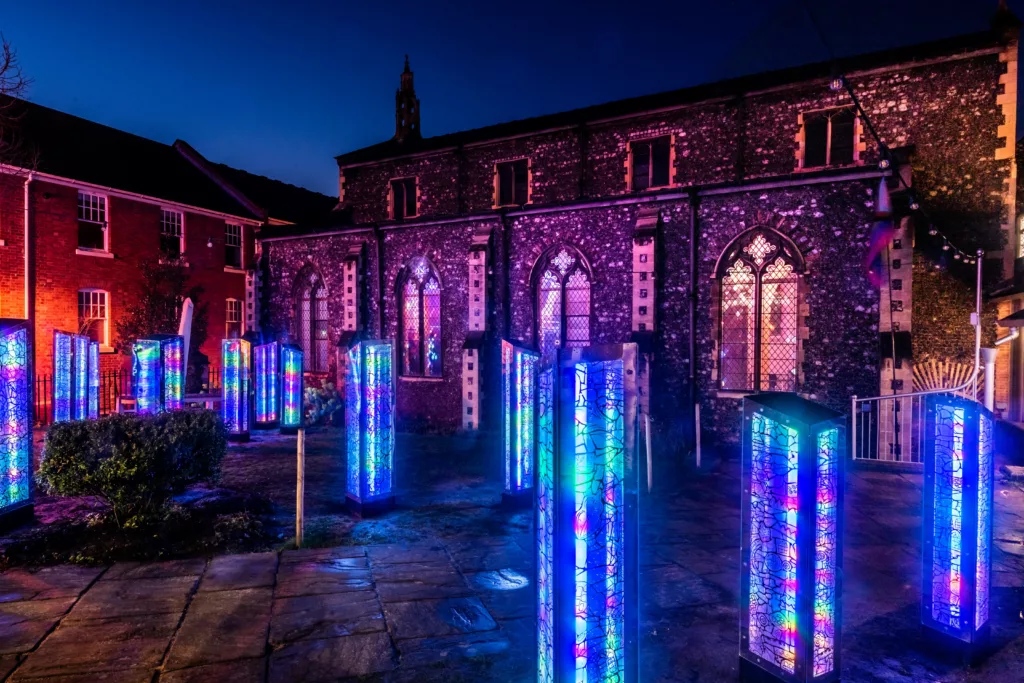
Flint by toyStudio at Norwich Arts Centre
Norfolk’s history is celebrated in the artwork Flint by toyStudio, a series of mirrored totems placed around the grounds of the Norwich Arts Centre. Delivery of Flint was led by Norwich BID. The artwork’s shapes are inspired by the organic forms of the knapped flint walls, seen at the Church of St Swithin located nearby. Norfolk is famous for the naturally occurring flint, often visible across fields and heaths.
During the day, the mirrored surfaces reflect their immediate surroundings, creating a distorted mirror maze for the public to interact with. At night, the lights illuminate, and the mirror surfaces transform into a collection of seemingly endless infinity mirrors. The visible patterns have been derived through workshops exploring local features with members of the community and interpreted by Norwich-based illustrator Ellen Harling.
Flint has been created by artist Toby Plunkett, working with art collective toyStudio, who has previously designed work that has been installed in Canary Wharf, Sloane Square London and Arizona, USA.
Norwich Arts Centre is a live music venue, theatre and art gallery and a key part of Norwich’s cultural community, making it the perfect host for this artwork. St Benedicts Street is steeped in rich cultural heritage – with independent boutiques, galleries, churches and eateries there is plenty in the area to satisfy the senses.
The other artworks which form the Norfolk Way Art Trail are Flock at Diss Mere, Iron Reef at Reedham Ferry Inn, Honing Passage at Honing Station and Interval at Eastbourne Place in Norwich.

Redwell Brewery Tour and Beer Tasting
Small, passionate and bubbly as the beer, the brilliant award-winning Redwell Brewery taproom team are well known for on (and off!) site merriment, guaranteeing you’ll drink, you’ll laugh, and you’ll learn! There’s a warm welcome for everyone whether you’re a long seasoned beer-lover or brand new to the world of craft brewing, there’s something special here for you.
So what happens during a tour? You’ll have an hour behind the scenes discovering each stage of the brewing process with entertaining guided tastings of all the excellent beers brewed at Redwell. Then enjoy two pints of your choice either to quaff on-site or to take away to enjoy at home. Mostly you’ll have a good laugh as the Brewery Tours are designed to be both informative and entertaining! The core range is created from scratch in small batches here at the Trowse brewery in Norwich, using locally grown Norfolk malt and all kinds of exciting hops from around the world. Beers range from the popular Chewy Passionfruit IPA and fruity Extra Pale Ale to a clear, golden, easy drinking Norwich Pilsner with the flavoursome depth of good Czech-style lager and a good honest stout called Lusty Newton, a proper winter comfort drink for dark beer lovers.
At Redwell, they believe in beers for everyone so the whole range is certified vegan and gluten-free, meaning everything can be enjoyed by one and all. Join them at the on-site Taproom to get yours!

Flock by toyStudio, at Diss Mere
Part of the Norfolk Way Art Trail, Flock by toyStudio is formed of a collection of curved, metallic, tubes which vary in length and twist upwards around a larger central spiral. It is inspired by flights of birds, schools of fish and the swarms of eels, which are synonymous with Diss Mere and the nearby River Waveney. It also represents the movements of Diss’ own residents, just as the Mere’s wildlife has migrated to Diss over the years, many different communities have arrived in Diss and explored its culture and heritage.
Diss-based writer, Bel Greenwood, delivered a series of creative workshops in Diss, gathering memories and stories from the local community to create a poem. The poem is imprinted on the artwork, reflecting people’s responses to Diss’ landscape, culture and heritage.
The artwork responds directly to the Mere, with its form evoking its mysterious depth. The artwork’s creator, toyStudio, reflects the uniqueness of the Mere, complementing the environment it sits in. Some Flock members are highlighted in yellow, green, blue, and purple, colours which reference Diss’ historic cloth and linen market.
The other artworks which form the Norfolk Way Art Trail are Iron Reef at Reedham Ferry Inn, Honing Passage at Honing Station, Interval at Eastbourne Place in Norwich and Flint at Norwich Arts Centre.

Learn the Skill of Saori Weaving
Want to learn a wonderfully expressive new skill? Saori freestyle hand weaving originated in Japan. It’s open to everyone regardless of age, gender or physical ability, with no rules, no tricky patterns, no worries about straight edges and no mistakes!
The ‘sa’ of Saori comes from Zen vocabulary, meaning everything has its own individual dignity, the ‘ori’ means weaving.
In a Saori Studio the looms are set up with warp threads so you can come in, sit down and weave. Saori weaving began when Misao Jo was 57 years old. While hand weaving an obi (belt) for her kimono, she noticed a warp thread was missing and was delighted to find this ‘mistake’ made a beautiful pattern. Her ‘flawed’ obis were so full of life, people wanted to make their own. Students learned the basic techniques of using a loom and then had the opportunity to ‘paint with yarn’, be adventurous and express themselves freely with pure joy. This spontaneous approach to weaving finds ‘the beauty with lack of intention’, inspiring confidence in your own creativity. It’s a generous invitation to consider the difference between a machine and a human being, inspire one another and ‘look out through eyes that shine’. Magical!
The Saori Shed is part of a fantastic East Anglian creative studio in Diss. Through their charity, designermakersCIO, this vibrant community of craftspeople and artists nurtures local talent and makes arts accessible to all. Check out their Save Our Story campaign, aiming to secure a bright future.
Build your own itinerary
If you fancy creating your own itinerary for a day trip to Norfolk or a longer visit, it couldn’t be simpler. Just go to Search Activities and select from our wide range of free and paid-for experiences, saving any that capture your imagination with the click of a button.
Once you’ve finished, you’ll find all the information stored in My Favourite, where you can drag and drop activities to create your own day-by-day itinerary! You can download this to a calendar and even share it with friends.
